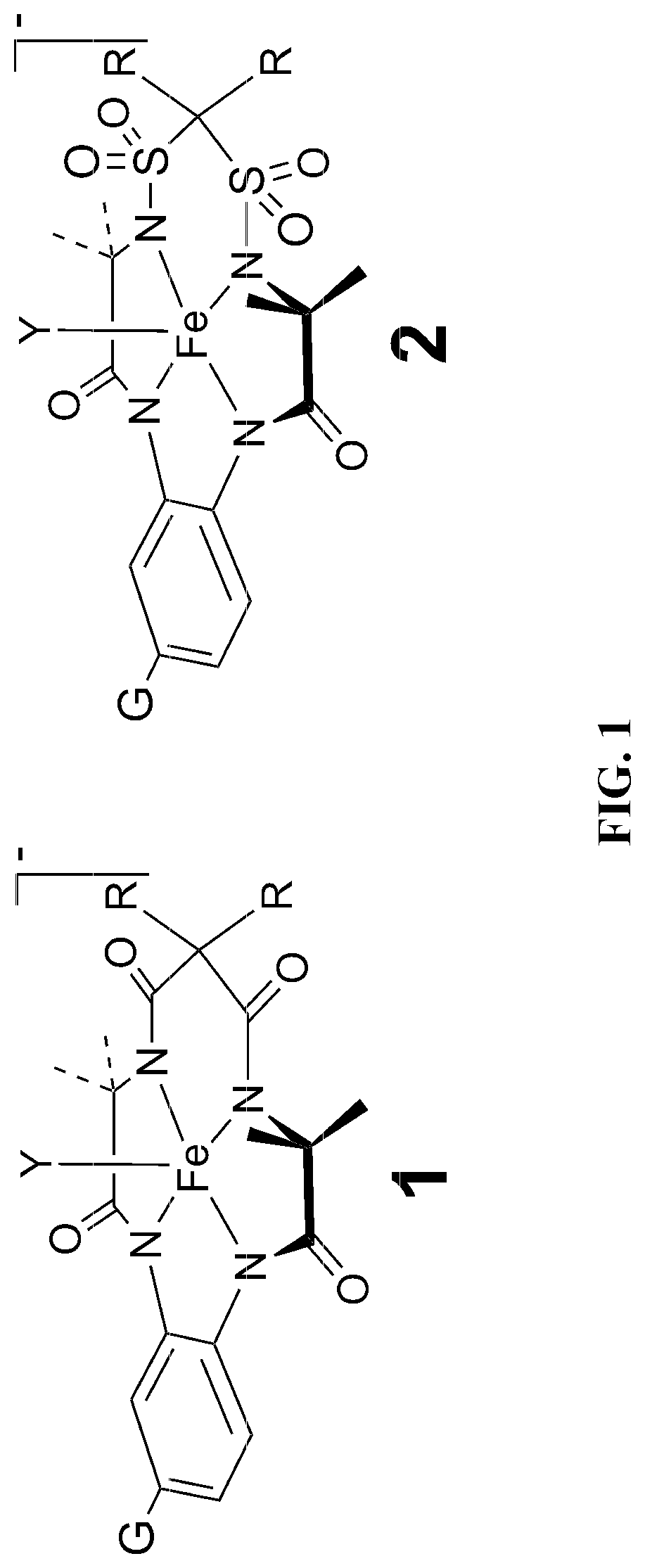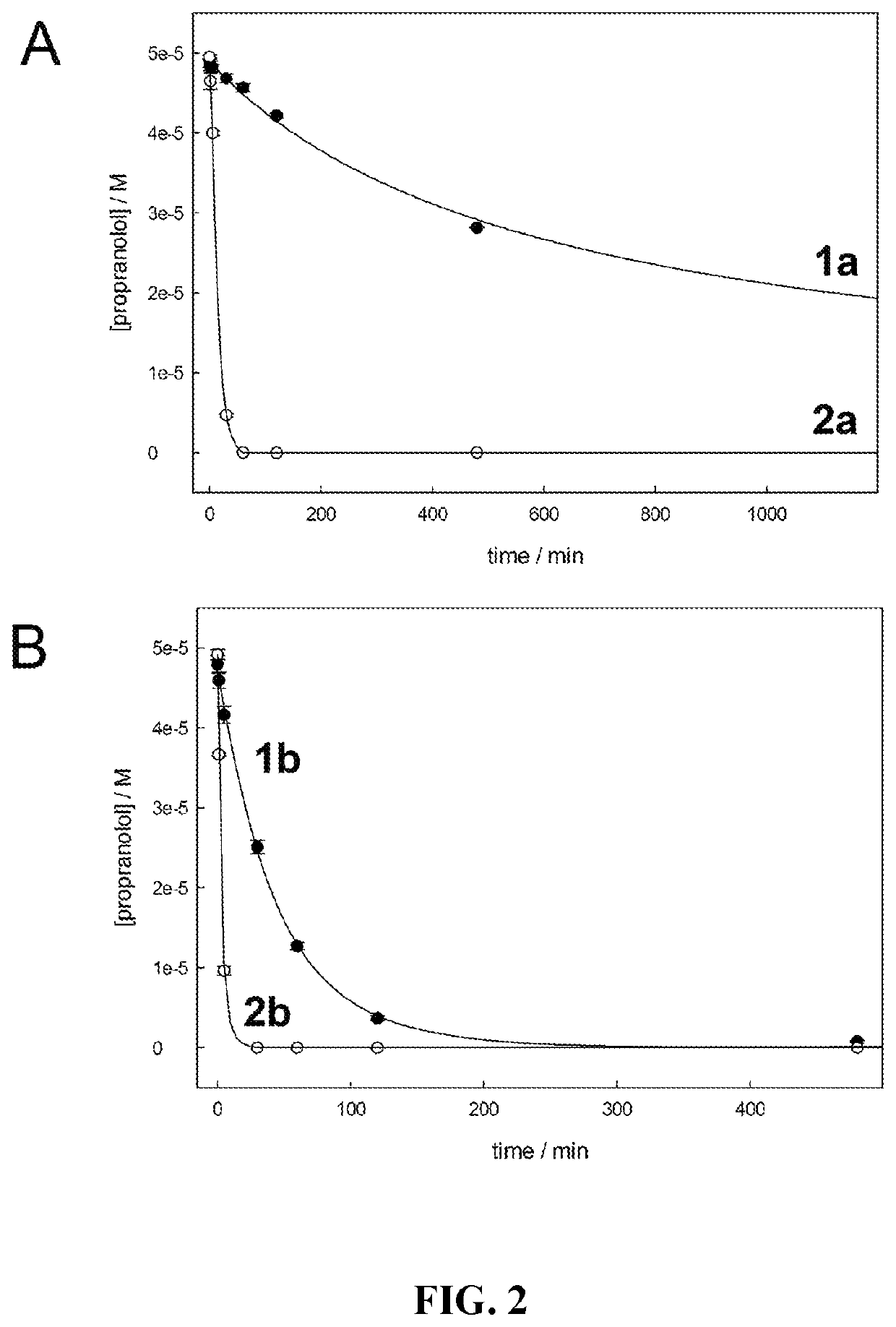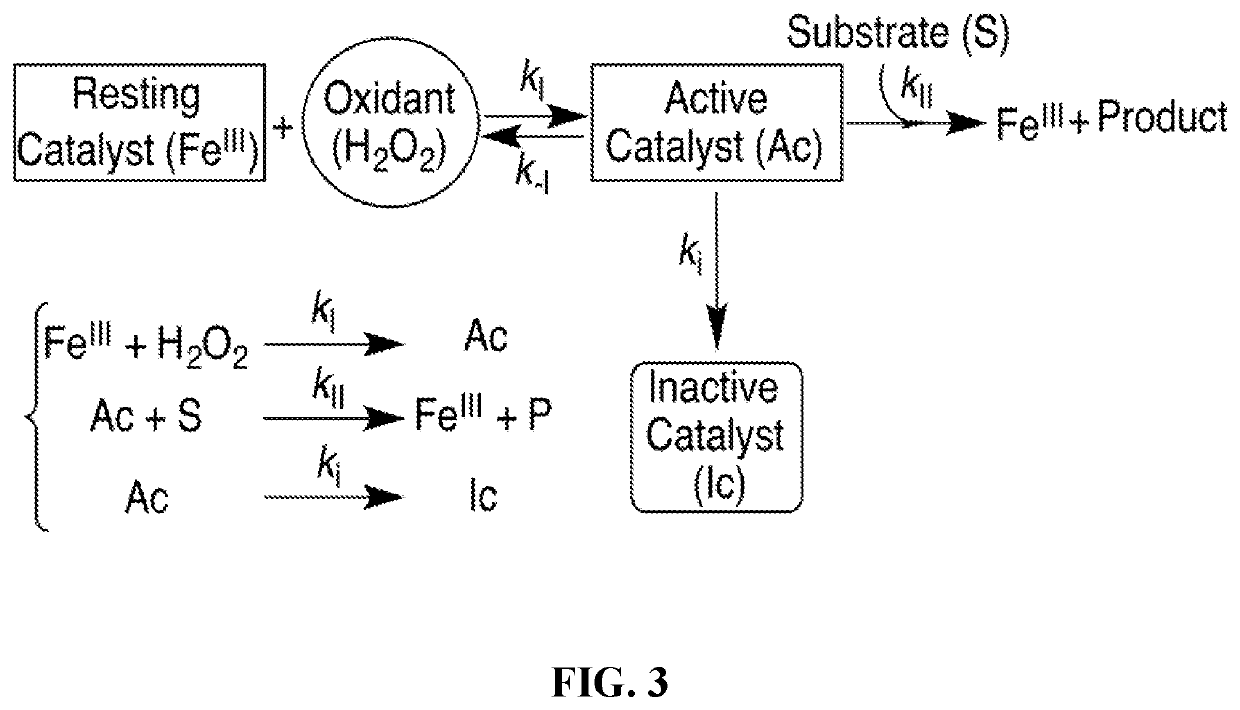[0017]R1 and R2 are linked or nonlinked and each is independently selected from the group consisting of substituents which form strong bonds intramolecularly within said R1 and R2 and with the carbon of the Y unit to which each is bound, which in the cases of H or D may be labile to acid dissociation, are unable due to size to interact with a metal center when X is occupied by a metal, are sterically hindered, conformationally hindered to further restrict oxidative degradation of a metal complex of the compound when the complex is in the presence of an oxidizing agent, or together with an R substituent or two R substituents on an adjacent carbon, E or Z in the same Y unit, form a mono- or poly-substituted or unsubstituted saturated or unsaturated ring. By way of example, R1 and R2 may be selected from hydrogen or deuterium, which may be labile to acid dissociation, alkyl, aryl, halogen, haloalkyl, perhaloalkyl, haloaryl, perhaloaryl, particularly methyl, ethyl, or CF3, substituted or unsubstituted-carbazole, carboxyl, amino, substituted amino, amido (—NHCOR, —NRCOR, —NHSO2R, —NRSO2R, —NHPO2R−, —NRPO2R−, NRPO(OR)R, NRPO(OR)R), fully oxidized or partially oxidized or substituted or unsubstituted carboxylic acid derivatives including, but not limited to, carboxylate (—CO2−), carboxylic acids (—CO2H), esters (—CO2R), amides (—CONH2, —CONHR, —CONR2), and combinations thereof, fully oxidized or partially oxidized substituted or unsubstituted sulfur substituents including, but not limited to, sulfonates (—SO3−, —SO2(OH), —SO2OR), sulfones (—SO2R), and sulfonamides (—SO2(NH2), —SO2(NHR), —SO2(NR2)), fully oxidized or partially oxidized substituted or unsubstituted phosphorus substituents including, but not limited to, phosphates (—PO32−, —PO2(OH)−, —PO(OH)2), alkyl phosphate (—PO2(OR)−), phosphonate (—PO(OR)2), phosphinate (—PO(OR)R), phosphine oxide (—P(O)R2), phosphonamides (—PO2(NR2)−, —PO(NR2)2, —PO(OR)(NR2)), phosphines (—PR3), nitrile, nitro, hydroxyl, alkoxy, aryloxy, a substituted or unsubstituted cycloalkyl ring, a substituted or unsubstituted cycloalkenyl ring, a substituted or unsubstituted saturated heterocyclic ring, a substituted or unsubstituted unsaturated heterocyclic ring, and combinations thereof, or may form, together with the carbon atom to which both are bound, substituted or unsubstituted three-, four-, five- or six-membered ring, such as a substituted or unsubstituted-cyclopropyl, -cyclobutyl, -cyclopentyl including but not limited to dibenzocyclopentyl, or -cyclohexyl, or together with a substituent on an adjacent E in the same Y unit form a mono- or poly-substituted or unsubstituted saturated or unsaturated ring, or joining with its paired R substituent together with a substituent on an adjacent E in the same Y unit form a mono- or poly-substituted or unsubstituted saturated or unsaturated ring.
[0037]The present invention pertains to the novel changes to the macrocyclic structure giving new compositions of matter that increase the robustness of tetra-aza macrocyclic ligands such that one can obtain ligand systems that can better support catalysis, which is based on highly reactive metal-oxo intermediates similar to those of the monooxygenases and peroxidases, than any small molecule replicas heretofore. The degradation chemistry that rendered the described changes necessary for improvement of catalytic performance was completely unexpected. Most significantly, the new systems described herein exhibit significantly improved technical performance with highly desirable O-atom transfer oxidants, especially peroxides, as well as electrodes and / or oxidized complexes regenerated by electrodes. These superior activities make these new systems available for a wide range of technological oxidation applications where there is significant promise of obtaining chemically- and cost-effective catalytic processes. The advantages over prior catalysts pertain not only to improved technical performances but also to superior cost performances.
[0040]In this regard, in the process of investigating the reactivities of the catalysts depicted in FIG. 1, we have discovered a novel and unanticipated catalyst inactivation pathway, which has never been observed for the amido-N macrocyclic activators. This pathway occurs when R1 and / or R2 are H or D and appears to be associated with acid dissociation of H+ or D+ rendering a much less stable catalyst system. When allowed to stand in deuterium oxide (D2O), the R1 and R2 protons rapidly exchange to become R1 and R2 deuterons. Importantly, the exchange process must proceed by dissociation of H+ or D+ from the carbon atom bridging the sulfonamides. The deprotonated form turns out to be much more sensitive to decay under the conditions of oxidative catalysis. This “kill switch” is most turned on in the activated form of the catalyst and becomes more evident with increasing pH. Thus, at elevated pH the catalysts of Structure 2 having H or D as R1 and / or R2 decay more rapidly than expected by the comparative behavior of all other catalysts. Because the catalysts of Structure 2 are so reactive in water, oxidation catalysis proceeds so rapidly that, for example, in water purification most micropollutants are removed in minutes whereas the deprotonation “kill switch,” a completely separate degradation process from those arising from nucleophilic attack at organic amido-N ligands, causes a slower degradation not evident in any prior TAML activator. Because of the balance manifested in these competing reactivities, this “kill switch” is an overall positive factor in the embodied compositions, allowing us to tune the rate of catalyst inactivation and bring added safety by providing a safeguard against release to the environment of catalysts that have already done their required job extraordinarily well. At elevated pHs, the inactivation of Structure 2 catalysts is very rapid, prescribing a method for catalyst disposal when necessary.
[0048]R1 and R2 are key substituents in the design of the robust chelate complex and catalysts of the present invention. R1 and R2 are preferably hydrogen or deuterium, which may be labile to acid dissociation, alkyl, aryl, halogen, haloalkyl, perhaloalkyl, haloaryl, perhaloaryl, particularly methyl, ethyl, or CF3, amino, substituted amino, amido (—NHCOR, —NRCOR, —NHSO2R, —NRSO2R, —NHPO2R−, —NRPO2R−, —NHPO(OR)R, NRPO(OR)R), fully oxidized or partially oxidized or substituted or unsubstituted carboxylic acid derivatives including, but not limited to, carboxylate (—CO2−), carboxylic acids (—CO2H), (esters (—CO2R), amides (—CONH2, —CONHR, —CONR2), and combinations thereof, fully oxidized or partially oxidized substituted or unsubstituted sulfur substituents including, but not limited to, sulfonates (—SO3−, —SO2(OH), —SO2OR), sulfones (—SO2R), and sulfonamides (—SO2(NH2), —SO2(NHR), —SO2(NR2)), fully oxidized or partially oxidized substituted or unsubstituted phosphorus substituents including, but not limited to, phosphates (—PO32−, —PO2(OH)−, —PO(OH)2), alkyl phosphate (—PO2(OR)), phosphonate (—PO(OR)2), phosphinate (—PO(OR)R), phosphine oxide (—P(O)R2), phosphonamides (—PO2(NR2)−, —PO(NR2)2, —PO(OR) (NR2)), phosphines (—PR3), nitrile, nitro, a substituted or unsubstituted cycloalkyl ring, a substituted or unsubstituted cycloalkenyl ring, a substituted or unsubstituted saturated heterocyclic ring, a substituted or unsubstituted unsaturated heterocyclic ring, and combinations thereof, or may form, together with the carbon atom to which both are bound, substituted or unsubstituted three-, four-, five- or six-membered ring, such as a substituted or unsubstituted-cyclopropyl, -cyclobutyl, -cyclopentyl including but not limited to dibenzocyclopentyl, or -cyclohexyl, or together with a substituent on an adjacent E in the same Y unit form a mono- or poly-substituted or unsubstituted saturated or unsaturated ring, or joining with its paired R substituent together with a substituent on an adjacent E in the same Y unit form a mono- or poly-substituted or unsubstituted saturated or unsaturated ring. Intramolecular reactions between an oxo ligand in a functioning catalytic system and the R1 and R2 substituents in prior art complexes where R1 and R2 substituents were ethyl groups, for example, may still contribute to the rapid degradation of the chelate ligand as has been heretofore experienced. See the Collins' Group Patents in addition to the nucleophilic processes discussed. The complexes described in the Collins' Group Patents which include oxidatively resistant substituents in the R1 and R2 positions have proven to be capable of productive catalysis. However, current work has indicated that nucleophilic attacks such as hydrolysis and perhydrolysis of the amides of these complexes contribute significantly to their inactivation under catalytic conditions (i.e. when exposed to an oxidant in systems containing nucleophiles, especially aqueous systems). The substitution of the sulfonamides, phosphonamides, or other blocking groups at the E position in the compounds described herein are selected to retard degradation ascribed to increased resistance to hydrolysis or perhydrolysis at the substituted position. As such, the inclusion of at least one sulfonamide or phosphonamide or related functionality in the new complexes decreases the number of susceptible sites for hydrolysis or perhydrolysis or other forms of nucleophilic decay while increasing reactivity leading to more productive and often cheaper catalytic processes.
 Login to View More
Login to View More 


